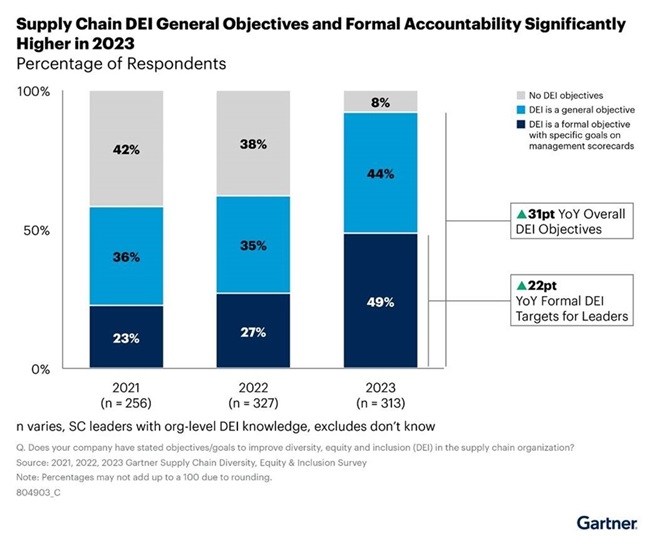Gartner survey finds 49% of supply chain organizations have formal DEI objectives
Data shows a 22 point annual increase for formalized diversity, equity, and inclusion (DEI) management targets

Nearly half of supply chain organizations have formal diversity, equity, and inclusion (DEI) objectives with specific targets on management scorecards, according to a survey by analyst company Gartner, Inc. The amount of supply chain organizations with formal DEI objectives has risen markedly year-over-year, from 27% in 2022 to 49% in 2023 (see Figure 1), Gartner explained.
“Supply chain organizations may have been expected to take a step back in pursuing DEI objectives in light of increased scrutiny and economic pressures,” said Dana Stiffler, Distinguished VP Analyst in Gartner’s Supply Chain Practice. “Our data instead showed strong gains, with a steep increase in representation of underrepresented races and ethnicities at every level of the supply chain. The key driver of these gains is an increase in accountability via formalized management goals.”
Gartner’s 2023 Supply Chain Diversity, Equity and Inclusion Survey polled 314 supply chain professionals from North America and Europe with active involvement in their organization’s DEI initiatives. The survey was conducted from September through October 2023, consisting of qualifying organizations with at least $250 million in annual revenues.
The survey data revealed major DEI gains, including that the percentage of full-time employees of underrepresented race/ethnicity in the supply chain organizations evaluated increased from 32% to 48%. Compared to 2022’s survey sample, the average representation of talent of underrepresented races and ethnicities is 1.5 times what it was in the 2022 sample.
The data showed strong alignment between DEI and broader business objectives, Gartner added. Among those who have either formal or general DEI objectives, respondents provided the following reasons for having such goals:
- Attracting new talent (68%)
- Engage and retain new employees (64%)
- Improve business performance (58%)
- Attract customers (48%)
- Reflect and support local communities (44%)
- Attract investors (40%)
“The recruitment focus of DEI initiatives is crucial, with a higher percentage of supply chain employees actively seeking a new job at the highest rate since 2021,” said Stiffler. “The focus on engagement and retention is also well-placed with supply chain employees less likely than other professions to be highly engaged or have a high intent to stay. Their discretionary effort in mid-2023 was at its lowest point in the past two years.”
“Say-Do Gap” Closing; Attrition Remains High
Beyond formal objectives, a second reason pushing representation higher in 2023 was a greater emphasis on actual DEI initiatives within supply chain organizations. In 2022, while 75% of supply chain organizations reported that they focused on some dimension of diversity, only 40% reported working on specific DEI projects or initiatives. Gartner refers to this gap between intention and tangible action as the “say-do gap.”
“While nearly the same proportion of organizations focused on one or more aspects of DEI in 2023, we saw a much higher percentage of supply chain respondents working on specific DEI projects and initiatives with measurable outcomes, jumping from 40% to 73%,” said Stiffler. “In 2023, the ‘say-do gap’ was reduced to nearly half of what it was in 2021; the connection between tangible action and improved DEI outcomes seems increasingly clear.”
The top four DEI initiatives invested in were learning and development (L&D), benefits, employee engagement and recruitment. In terms of effectiveness, employee engagement and L&D led the list, which is a departure from previous surveys, where inclusive leadership and recruitment were most effective.
While top-line findings in the survey showed progress on diversity efforts, 43% of respondents reported that the attrition rates of underrepresented talent were somewhat or significantly higher compared to their majority workforce. The data suggests talent pipelines need to be assessed and strengthened further to maintain recent gains. Chief supply chain officers (CSCOs) seeking to reduce attrition must evaluate a number of potential root causes, including the desire among these employees to seek career changes, the most highly cited reason underrepresented talent left their roles in 2023.
Gartner clients can read more in: 2023 Supply Chain DEI Survey: Broad Improvements in Workforce and Pipelines. Nonclients can learn more in Supply Chain Organization Design and Talent.

Article Topics
Gartner News & Resources
Gartner foresees sizeable uptake for next-gen humanoid robots Gartner survey finds 49% of supply chain organizations have formal DEI objectives The pluses propelling cloud warehouse management systems (WMS) Gartner: 26% of supply chain C-suite roles now filled by women What’s keeping the supply chain C-Suite up at night? Materials handling robot basics Talking Supply Chain Podcast: Insights on leaders: The Top 25 More GartnerLatest in Materials Handling
Vehicle-mounted computers: Beyond rugged New packaging idea for the cold chain Autonomous mobile robots (AMRs) offer modern solution to challenges of traditional farming Hyster-Yale Group provides students with real-world AI experience in 2024 Kellogg Design Challenge KION Group’s board extends CEO Rob Smith’s contract by five years UniCarriers Forklift joins Quality Equipment in opening celebration of new location Largest Automate on record opens in Chicago on Monday May 6th More Materials HandlingSubscribe to Materials Handling Magazine

Find out what the world's most innovative companies are doing to improve productivity in their plants and distribution centers.
Start your FREE subscription today.
April 2024 Modern Materials Handling

Latest Resources










